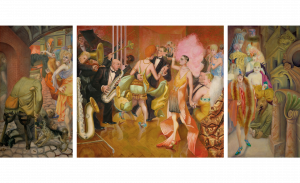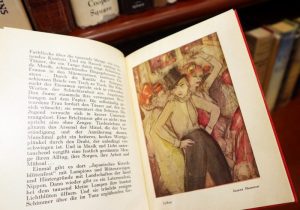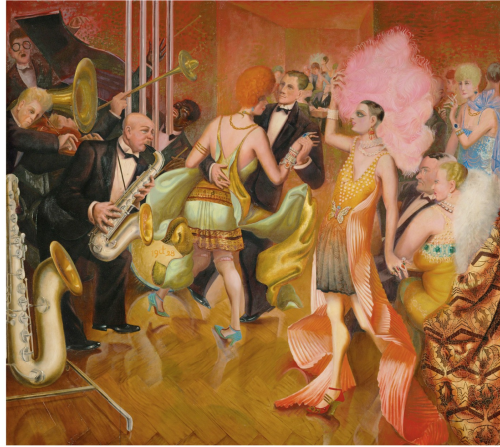By Andy Stewart MacKay
After the horrors of the Great War, “All values were changed” wrote the novelist Stefan Zweig of 1920s Berlin; the city “transformed into the Babylon of the world”. It wasn’t just Berlin that was changed: London and Paris offered the leisured and the artistic innumerable opportunities for bohemian indulgence too. (“Bright Young Thing” Stephen Tennant dragging up at drug-enhanced Mayfair parties immediately springs to mind – as does the artist Tamara de Lempicka enjoying riotous lesbian orgies in a marquee beside the River Seine). But the flavour of Berlin’s “depravity” was uniquely democratic, and the city quickly gained a distinct reputation for erotic possibility not to be found elsewhere.

Otto Dix, Großstadt (Metropolis), 1927-1928, Kunstmuseum Stuttgart.
Neon-lit Berlin and its intoxicating atmosphere of hedonist abandon remains vividly evoked by Otto Dix’s 1928 triptych Metropolis. The city’s relatively-unlicensed climate drew into its orbit everyone from Francis Bacon, Stephen Spender, W. H. Auden and Christopher Isherwood to Djuna Barnes, Greta Garbo and, of course, Marlene Dietrich – described by historian Rory MacLean as “the singular Berliner”, who magically personified “sex without gender”. As exemplary Berlinerinnen of the period, alongside Die Dietrich, two others particularly stand out: sophisticatedly moderne journalist Sylvia von Harden (immortalised by a 1926 portrait by Otto Dix, recreated in the 1972 film Cabaret) and chic Egyptian-born Scottish singer Jean Ross (fictionalised by Isherwood as Sally Bowles and famously played by Liza Minelli in Cabaret). Sexually confidant and financially autonomous, these recently empowered “New Women” were, in almost every respect, strikingly different from their pre-war mothers.
By 1930 Berlin drew more than two million visitors each year, and many were thirsty for sexual adventure. Responding to international demand for its avantgarde scene, the following year Berlin-resident and writer Konrad Haemmerling (1888-1957), under the pseudonym “Curt Moreck”, published Fuhrer durch das “lasterhafte” Berlin : a travel guide to what he called his beloved “metropolis of pleasure”. Perhaps the very first alternative travel guide, his was cleverly marketed and pitched at the youthful “New” reader – and for a brief period became the indispensable guide to everything in Berlin that was “naughty”, “immoral” and “depraved”. Deploying the city tourist agency’s slogan, “A Visit to Berlin for Everyone!”, Moreck led his readers on a previously uncharted psycho-geographic journey through Berlin’s queerest hotspots. Acknowledging that “Every city has an official and an unofficial side”, his was explicitly a sketch of the unofficial. Illustrated by well-known artists of the day, the curious traveller could find everything they needed to know about all the fashionable bars, clubs, dancehalls and brothels – including pointers on which ones had the latest thing: telephones on their private tables, designed to facilitate and accelerate not just flirtatious encounters but overt sexual cruising.
Featuring numerous women-only bars and clubs, Moreck advocates modern women’s demand for the same sexual rights as men. Illustrations by Jeanne Mammen clearly both represent and reflect a strikingly modern female gaze, and one by Paul Kamm depicts the most famous lesbian bar of the day, Café Olala on Zietenstrasse. Drag clubs feature too, and with about eighty “Man to Man” bars, gay and bisexual men were spoilt for choice; affirming what historian Leif Jerram calls Berlin’s newly “self-identifying, stable emergent gay identity” at this time. According to Moreck, make-up was now, both for women and for queer men, less a “label” for sex-workers in the way it once was and more simply today’s fashionable “cosmetic uniform”. No longer were young Berliners genteelly promenading in the Tiergarten like the pre-war Bourgeois of their parents’ generation; their performative modernity instead involved a need to see and be seen on the streets and in the clubs. Berlin, Moreck declares, was – in the best possible sense – one vast masquerade, suffused with desire and almost limitless opportunities for erotic pleasure. Visitors only needed to walk the streets, he advised, take a tram or a tube train to feel what seemed, according to Leif Jerram, “by many at the time to be a hyper-sexualised experience”.
The tolerance of ordinary Berliners for all this decadence rested, according to Moreck, “more on indifference than on understanding”. But, after Adolf Hitler’s election as premier in January 1933 and the infamous Enabling Act of March that year, everything was to change. Haemmerling’s work was banned and, two months later, his guidebook burned – along with 25,000 other “un-German” books – in what the Nazis called Die Säuberung, “cleansing” fires on the streets of Berlin. A rare copy of Moreck’s influential publication, and some of the original illustrations it features, was recently included in the London Barbican Centre’s exhibition Into the Night: Cabarets & Clubs in Modern Art – not just because of its distinct visual appeal, but because it remains a unique historical document of unashamedly queer life in Berlin before its obliteration under Nazi rule.

Andy Stewart MacKay is an author and cultural historian.




